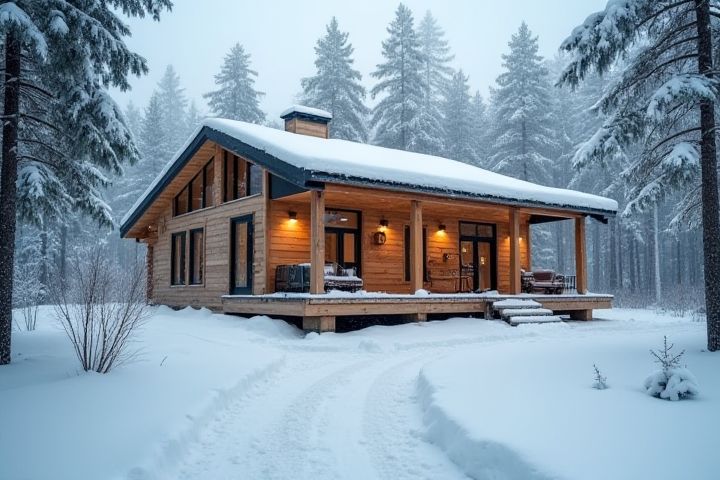
Building a house in winter can present unique challenges, such as cold temperatures and potential snowfall, but it is still feasible. Many construction materials, like concrete, can be used effectively in winter with appropriate precautions, such as using insulation blankets and heated enclosures. Proper planning is crucial; ensuring that the foundation is laid before the deep freeze sets in can prevent complications later on. Also, you might want to choose winter-adapted building techniques and equipment that streamline the construction process, like using heated tools or specialized machinery. When done right, winter construction can lead to a quick build time and potential cost savings, as fewer projects typically occur during this season.
Can You Build A House In Winter
Foundation challenges
Building a house in winter presents unique challenges, particularly concerning foundation work. Cold temperatures can lead to soil frost, increasing the risk of shifting and settling as the ground thaws. The use of insulated blankets and heated enclosures can facilitate proper curing of concrete, ensuring its strength and durability. You should also consider the potential for moisture and drainage issues, which can complicate excavation and foundation stability during the winter months.
Weather-related delays
Building a house in winter can pose significant weather-related challenges, including freezing temperatures and heavy snowfall that can cause delays. For instance, average winter temperatures in many regions can drop below 32degF, affecting concrete curing and making excavation work difficult. Ice accumulation on roofs and construction sites may lead to safety hazards, necessitating additional safety measures that further prolong the project timeline. When planning your construction timeline, consider that winter storms can result in lost days, potentially pushing completion dates into spring or summer.
Concrete curing issues
Concrete curing during winter involves specific challenges due to lower temperatures, which can significantly slow down the curing process and affect the strength of the mix. The optimal curing temperature for concrete is around 50degF (10degC), and when temperatures drop below 40degF (4degC), special precautions must be taken. Use insulation blankets or heating systems to maintain the concrete temperature above 50degF for at least the first 48 hours. Properly managing moisture levels is equally crucial, as frozen water in the mix can lead to cracking, decreasing the durability of your structure.
Increased heating costs
Building a house in winter can lead to increased heating costs due to the lower temperatures and the need for additional heating to maintain a workable environment on-site. Insulation materials may require specific temperature conditions for optimal installation, potentially delaying progress and escalating energy expenses. You must also consider frozen ground conditions, which may complicate excavation and foundation work, further extending the construction timeline and increasing costs. Proper planning, including energy-efficient building practices and strategies to minimize heat loss, can help reduce these winter-associated heating expenses.
Insulation importance
Building a house in winter offers unique challenges, making proper insulation crucial for energy efficiency and comfort. High-quality insulation materials, such as spray foam or fiberglass, help reduce heat loss and create a temperature-regulated environment, ensuring your construction progresses without weather delays. Adequate insulation not only maintains worker productivity in cold conditions but also prevents moisture buildup, mitigating the risk of mold development. By prioritizing insulation during winter construction, you enhance the long-term performance and durability of your home.
Snow removal needs
Building a house in winter requires meticulous snow removal strategies to ensure site accessibility and worker safety. Snow accumulation can reach up to several feet, necessitating the use of snow plows and shovels to clear areas around the foundation and materials. Regular snow removal is essential, as delays can extend the construction timeline and lead to elevated costs. You should also monitor weather forecasts closely to plan snow removal activities effectively, minimizing disruptions to the building process.
Material storage concerns
Building a house in winter requires careful consideration of material storage to prevent damage from cold temperatures and moisture. For instance, wood materials should be kept off the ground on pallets and covered with tarps to shield them from snow and ice, as moisture can lead to warping or mold. Similarly, concrete should be stored in a temperature-controlled environment, as extreme cold can hinder its curing process and weaken the final structure. You should also ensure that insulation materials are dry and stored in a temperature-stable area to maintain their effectiveness and prevent degradation.
Skilled workforce availability
Building a house in winter can be challenging, particularly due to limited skilled workforce availability, which may be affected by weather conditions and holiday schedules. Many construction workers prefer to take time off during the colder months, leading to a potential decrease in qualified labor. In regions where winter is harsh, the average availability of skilled workers can drop by 30-40%, impacting project timelines. Planning ahead and securing your workforce early can mitigate these challenges and ensure your project stays on track despite the seasonal obstacles.
Protective measures for trenches
When building a house in winter, it is crucial to implement protective measures for trenches to ensure proper structural integrity. Insulating materials, such as straw bales or thermal blankets, can help retain heat and prevent frost from penetrating the soil, which could compromise the foundation. Additionally, using heaters or heat lamps can further maintain a stable temperature within the trench, minimizing the risk of frozen ground disrupting construction activities. Proper drainage systems should also be established to manage any melting snow or ice, keeping the trenches dry and secure during the building process.
Potential for ice-related accidents
Building a house in winter presents unique challenges, particularly concerning the potential for ice-related accidents. With temperatures often dropping below freezing, the risk of ice accumulation on surfaces like scaffolding and walkways increases, exposing workers to slip hazards. Furthermore, ice can form inside plumbing systems, potentially causing costly damage and delays in construction timelines. It's crucial to implement safety measures such as anti-slip footwear and regular ice removal to minimize these risks during winter construction projects.
